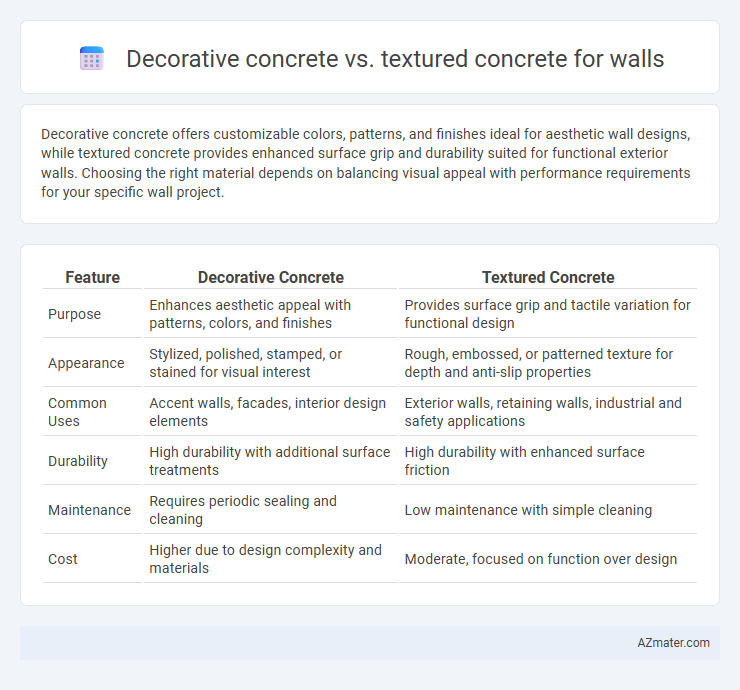Decorative concrete offers customizable colors, patterns, and finishes ideal for aesthetic wall designs, while textured concrete provides enhanced surface grip and durability suited for functional exterior walls. Choosing the right material depends on balancing visual appeal with performance requirements for your specific wall project.
Table of Comparison
| Feature | Decorative Concrete | Textured Concrete |
|---|---|---|
| Purpose | Enhances aesthetic appeal with patterns, colors, and finishes | Provides surface grip and tactile variation for functional design |
| Appearance | Stylized, polished, stamped, or stained for visual interest | Rough, embossed, or patterned texture for depth and anti-slip properties |
| Common Uses | Accent walls, facades, interior design elements | Exterior walls, retaining walls, industrial and safety applications |
| Durability | High durability with additional surface treatments | High durability with enhanced surface friction |
| Maintenance | Requires periodic sealing and cleaning | Low maintenance with simple cleaning |
| Cost | Higher due to design complexity and materials | Moderate, focused on function over design |
Introduction to Decorative and Textured Concrete Walls
Decorative concrete walls enhance aesthetic appeal through techniques such as stamping, staining, or engraving, creating customized patterns and colors that mimic natural materials like stone or wood. Textured concrete walls emphasize surface depth and tactile qualities, using methods like bush hammering, sandblasting, or ribbing to provide functional anti-slip or acoustic properties. Both options offer durable, versatile solutions suited for interior and exterior applications, balancing visual impact with structural performance.
Key Differences Between Decorative and Textured Concrete
Decorative concrete incorporates pigments, stains, and stamped patterns to enhance aesthetic appeal, offering a wide range of customizable colors and designs for walls. Textured concrete emphasizes surface relief and tactile finishes, such as exposed aggregate or broom finishes, providing enhanced grip and a rugged appearance. The key difference lies in decorative concrete's focus on visual creativity, while textured concrete prioritizes functional surface variation and durability.
Popular Decorative Concrete Finishes for Walls
Popular decorative concrete finishes for walls include exposed aggregate, stamped patterns, and acid-etched surfaces, each providing unique aesthetic and tactile qualities. Textured concrete, such as broom-finished or sandblasted walls, enhances grip and visual depth while maintaining durability and weather resistance. Selecting between decorative and textured concrete depends on design intent, with decorative finishes emphasizing artistic appeal and textured finishes focusing on functional surface variation.
Common Textured Concrete Techniques for Walls
Textured concrete walls utilize techniques such as broom finishing, stamping, and acid etching to create visually appealing surfaces with enhanced grip and durability. These methods allow for diverse patterns and tactile finishes that improve both aesthetics and functionality compared to plain decorative concrete. Common textured concrete techniques for walls offer customizable designs while maintaining structural integrity and resistance to weathering.
Aesthetic Appeal: Style and Design Comparisons
Decorative concrete offers a wide range of colors, patterns, and finishes that mimic natural materials like stone or wood, enhancing wall aesthetics with a high level of customization and elegance. Textured concrete provides a tactile surface with varied reliefs and embossed designs, delivering a more rugged and industrial look suitable for contemporary or rustic styles. Both options improve wall appeal, but decorative concrete excels in versatility and intricate design potential, while textured concrete emphasizes depth and physical dimension.
Durability and Maintenance: Decorative vs Textured Concrete
Decorative concrete offers high durability with enhanced resistance to wear and weather due to sealants and finishes that protect against staining and cracking. Textured concrete provides robust strength but may require more frequent maintenance to prevent dirt accumulation and surface wear in intricate patterns. Both types demand regular cleaning, but decorative concrete generally benefits from easier upkeep because of its protective layers.
Cost Factors: Budgeting for Concrete Wall Finishes
Decorative concrete for walls typically involves higher costs due to specialized materials like stains, dyes, and intricate finishing techniques, while textured concrete offers a more budget-friendly alternative with simpler application methods such as stamping or broom finishes. Budgeting for concrete wall finishes requires considering labor intensity, surface preparation, and the durability of chosen materials, which directly impact long-term maintenance expenses. Selecting between decorative and textured concrete hinges on balancing aesthetic goals against project budget constraints and expected lifecycle costs.
Application Process: Installation Considerations
Decorative concrete for walls involves intricate stamping or coloring techniques applied during the curing process, requiring skilled labor and precise timing to achieve desired aesthetic effects. Textured concrete relies on surface treatments such as brushing, etching, or embedding aggregates after the concrete sets, focusing on durability and slip resistance. Installation considerations include substrate preparation, curing conditions, and selecting appropriate sealants to ensure long-lasting appearance and structural integrity.
Best Use Cases for Decorative and Textured Concrete Walls
Decorative concrete walls excel in creating visually appealing surfaces with customized patterns, colors, and finishes ideal for feature walls, commercial facades, and residential accent walls. Textured concrete walls provide enhanced durability and slip resistance, making them suitable for exterior retaining walls, garden boundaries, and industrial applications requiring functional surface roughness. Selecting decorative concrete is best for aesthetic-driven spaces, while textured concrete serves practical needs in high-traffic or outdoor environments.
Choosing the Right Concrete Finish for Your Wall Project
Decorative concrete offers customizable colors, patterns, and finishes that enhance aesthetic appeal, making it ideal for walls where design is paramount. Textured concrete provides increased durability and slip resistance, with various surface patterns that improve grip and visual depth suitable for exterior or high-traffic areas. Selecting the right finish depends on whether the project prioritizes artistic expression or functional surface qualities for the wall.

Infographic: Decorative concrete vs Textured concrete for Wall
 azmater.com
azmater.com